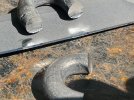Many terms from the
Young's modulus has been used here. I'm no physic expert, but let put it in scenario to see them more clear. The force applied to the edge (vertical force) and the force applied to the blade (lateral force) are two different thing, therefore 2 different kinds of toughness.
Yield strength: maximum amount of stress that material can withstand while staying in the elastic (reversible) deformation regime.
- This is where the "flex test" has it value. This is what you and the Youtuber looking for when you guys do need to pry and do other abusive action.
- Flex test shouldn't be just angle bent, it needs to have a force reader on it as well.
- It is why the spring steel is used for blade.
Ultimate strength: The strength of plastic deformation (where the thing can turn back to its original form by itself).
- Edge rolled easy is the sight of low yield strength, rather than anything else. And if it is rolled or permanently flexed, what is the toughness even for?
- High ultimate strength is usually mistaken for high toughness, but it is also not the case. Tou can't pry

with with something flexed.
Toughness: amount of energy that a material can absorb before fracture.
- So basically how much it takes before it break when it breaks. Total of both kind of strengths the thing has.
Geometry: Things like I-beam is stronger, both strength and toughness, for the same mass and other quality compare to a square beam.
- The blade fuller is the way of shaving the weight with minimal reduction on the blade strength.
Edit: Young's modulus however, has nothing to do with edge retention. Also, what do you consider a blade to be broken? When there is plastic deformation or when it is shattered and broken into piece? /end edit
Thicker blade stock will always add more strength and toughness, but then you get heavier thing. This is the case for many 1095 knives, they are just heavy blade. And with the tang, the full width tang is loved for more strength. Yet, rat tang with the right geometry of the angle between the blade and the tang, it create a strong yet lighter blade (like the sharp angle on Kabar is way weaker than a rounded angle on other rat tang).
Physic doesn't care about your opinion. Overbuild is easy, but not the most performance.
The Nerd's test is the way that a scientific test should go by, by keep the environment, size and criteria as close as possible, with only few things different to test the different behaviors. Though, Larrin's toughness test results used the lateral force strike to determinate the strength of the steel, which might have a different behavior of toughness compare to vertical strike on the edge. He does have vertical strike test on the blade, but it was not included to his final table.


 with with something flexed.
with with something flexed.